Business Analytics: Stock Portfolio Analysis and Optimization
VerifiedAdded on 2022/09/02
|12
|3016
|19
Project
AI Summary
This project presents a business analytics analysis of a stock portfolio comprising Jacobs Engineering Group Inc., Johnson & Johnson, Loews Corporation, Ladder Capital Corp, and Johnson Controls International plc. The analysis includes an examination of historical stock data, volatility calculations, and the prediction of future stock prices using simple regression and extrapolation techniques. The project formulates an optimization setup using linear programming to maximize returns subject to risk constraints, constructing a hypothetical portfolio. Predicted profits are then compared with observed profits, highlighting discrepancies and analyzing the factors contributing to these differences. The report provides detailed calculations, comparisons, and conclusions regarding the performance and risk associated with each stock and the overall portfolio, offering a comprehensive overview of financial modeling and investment strategies.
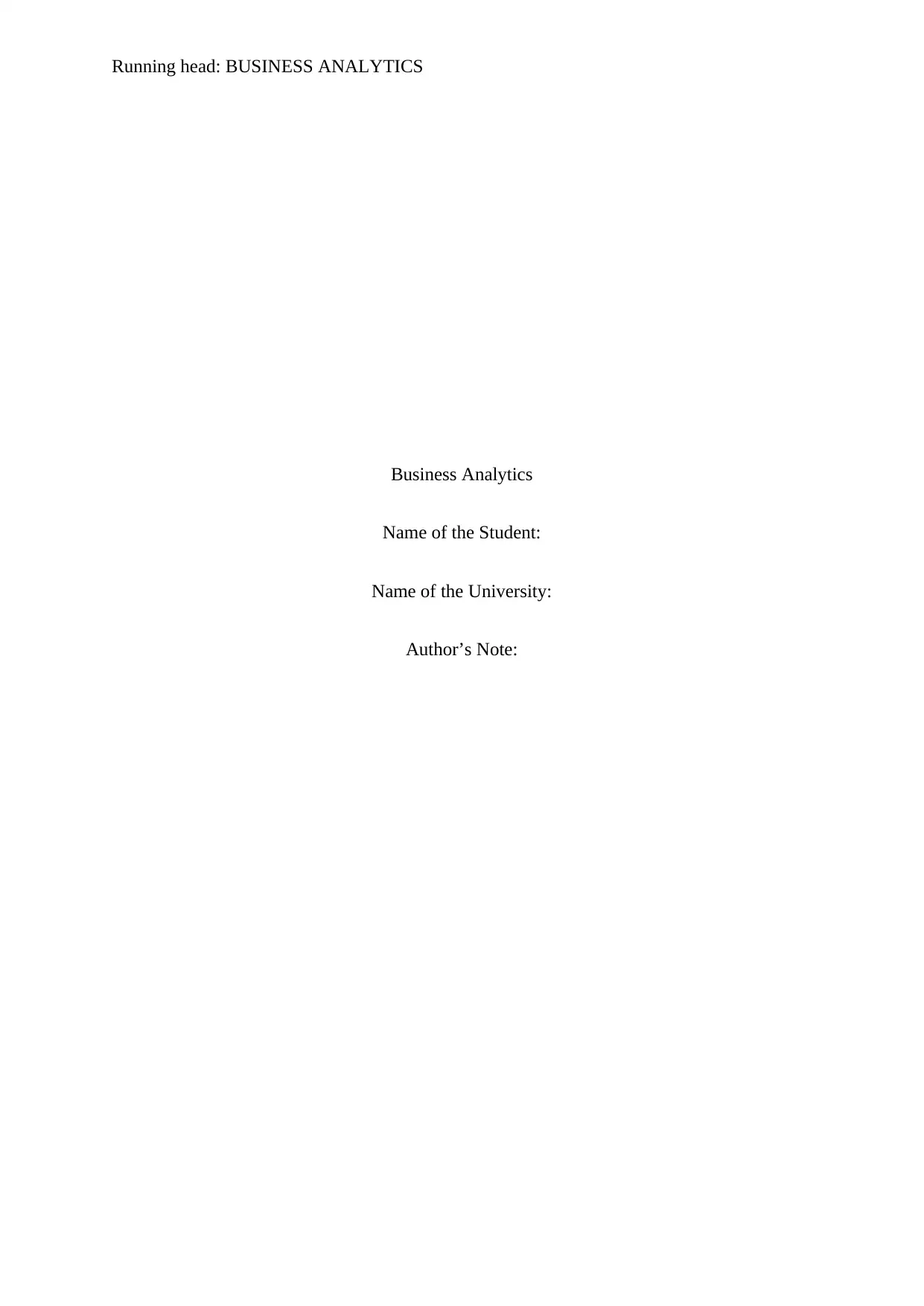
Running head: BUSINESS ANALYTICS
Business Analytics
Name of the Student:
Name of the University:
Author’s Note:
Business Analytics
Name of the Student:
Name of the University:
Author’s Note:
Paraphrase This Document
Need a fresh take? Get an instant paraphrase of this document with our AI Paraphraser
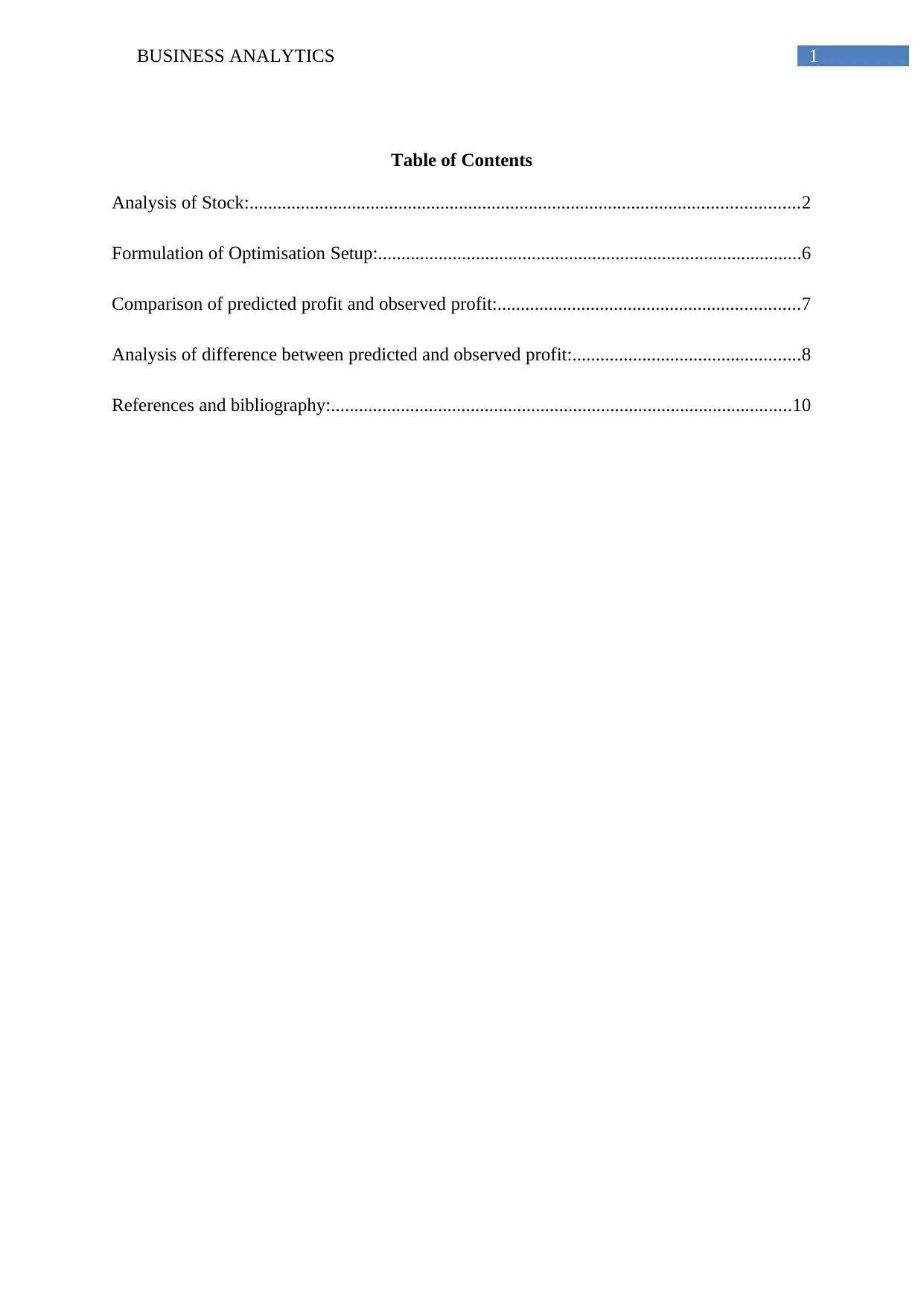
1BUSINESS ANALYTICS
Table of Contents
Analysis of Stock:......................................................................................................................2
Formulation of Optimisation Setup:...........................................................................................6
Comparison of predicted profit and observed profit:.................................................................7
Analysis of difference between predicted and observed profit:.................................................8
References and bibliography:...................................................................................................10
Table of Contents
Analysis of Stock:......................................................................................................................2
Formulation of Optimisation Setup:...........................................................................................6
Comparison of predicted profit and observed profit:.................................................................7
Analysis of difference between predicted and observed profit:.................................................8
References and bibliography:...................................................................................................10
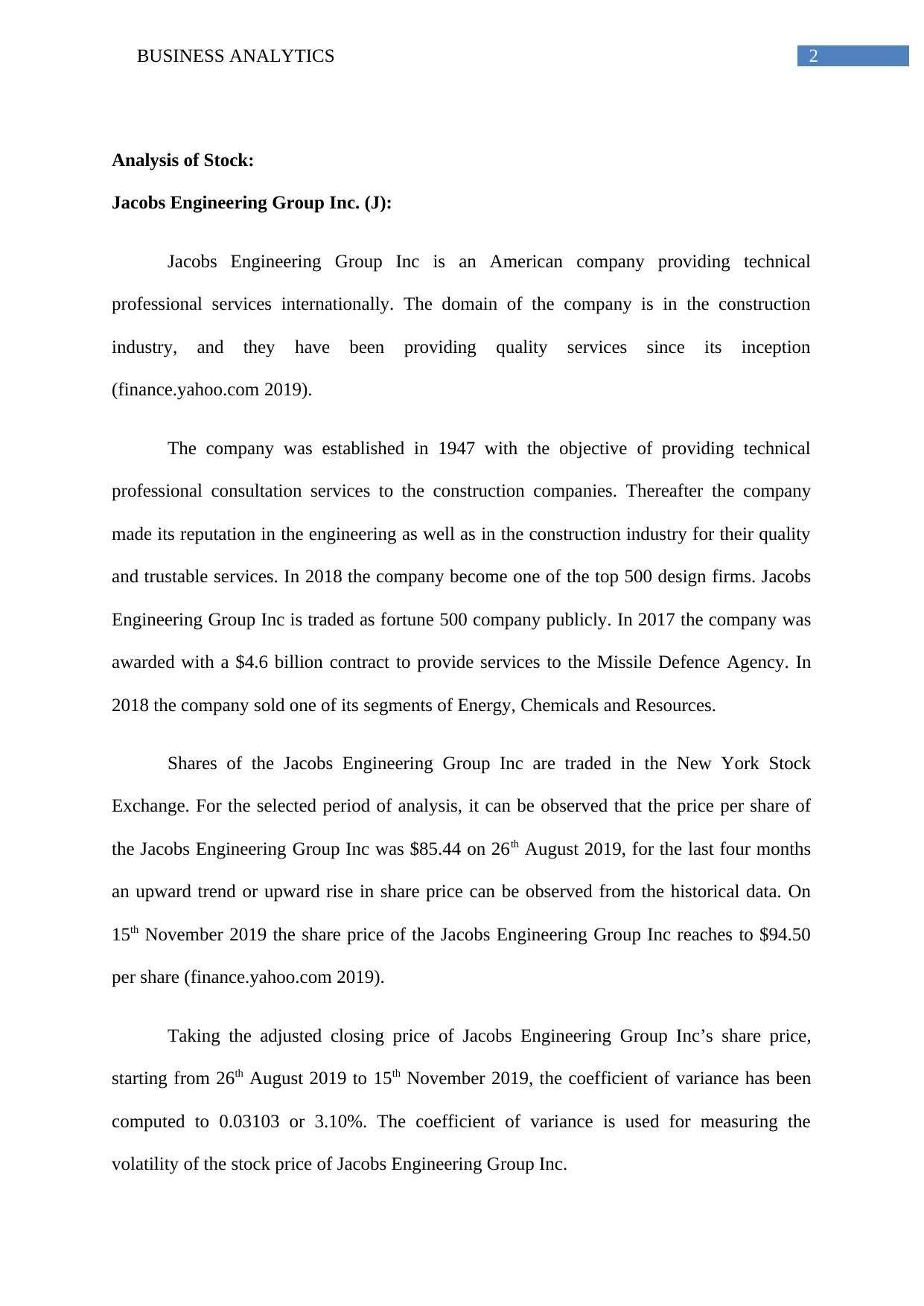
2BUSINESS ANALYTICS
Analysis of Stock:
Jacobs Engineering Group Inc. (J):
Jacobs Engineering Group Inc is an American company providing technical
professional services internationally. The domain of the company is in the construction
industry, and they have been providing quality services since its inception
(finance.yahoo.com 2019).
The company was established in 1947 with the objective of providing technical
professional consultation services to the construction companies. Thereafter the company
made its reputation in the engineering as well as in the construction industry for their quality
and trustable services. In 2018 the company become one of the top 500 design firms. Jacobs
Engineering Group Inc is traded as fortune 500 company publicly. In 2017 the company was
awarded with a $4.6 billion contract to provide services to the Missile Defence Agency. In
2018 the company sold one of its segments of Energy, Chemicals and Resources.
Shares of the Jacobs Engineering Group Inc are traded in the New York Stock
Exchange. For the selected period of analysis, it can be observed that the price per share of
the Jacobs Engineering Group Inc was $85.44 on 26th August 2019, for the last four months
an upward trend or upward rise in share price can be observed from the historical data. On
15th November 2019 the share price of the Jacobs Engineering Group Inc reaches to $94.50
per share (finance.yahoo.com 2019).
Taking the adjusted closing price of Jacobs Engineering Group Inc’s share price,
starting from 26th August 2019 to 15th November 2019, the coefficient of variance has been
computed to 0.03103 or 3.10%. The coefficient of variance is used for measuring the
volatility of the stock price of Jacobs Engineering Group Inc.
Analysis of Stock:
Jacobs Engineering Group Inc. (J):
Jacobs Engineering Group Inc is an American company providing technical
professional services internationally. The domain of the company is in the construction
industry, and they have been providing quality services since its inception
(finance.yahoo.com 2019).
The company was established in 1947 with the objective of providing technical
professional consultation services to the construction companies. Thereafter the company
made its reputation in the engineering as well as in the construction industry for their quality
and trustable services. In 2018 the company become one of the top 500 design firms. Jacobs
Engineering Group Inc is traded as fortune 500 company publicly. In 2017 the company was
awarded with a $4.6 billion contract to provide services to the Missile Defence Agency. In
2018 the company sold one of its segments of Energy, Chemicals and Resources.
Shares of the Jacobs Engineering Group Inc are traded in the New York Stock
Exchange. For the selected period of analysis, it can be observed that the price per share of
the Jacobs Engineering Group Inc was $85.44 on 26th August 2019, for the last four months
an upward trend or upward rise in share price can be observed from the historical data. On
15th November 2019 the share price of the Jacobs Engineering Group Inc reaches to $94.50
per share (finance.yahoo.com 2019).
Taking the adjusted closing price of Jacobs Engineering Group Inc’s share price,
starting from 26th August 2019 to 15th November 2019, the coefficient of variance has been
computed to 0.03103 or 3.10%. The coefficient of variance is used for measuring the
volatility of the stock price of Jacobs Engineering Group Inc.
⊘ This is a preview!⊘
Do you want full access?
Subscribe today to unlock all pages.

Trusted by 1+ million students worldwide
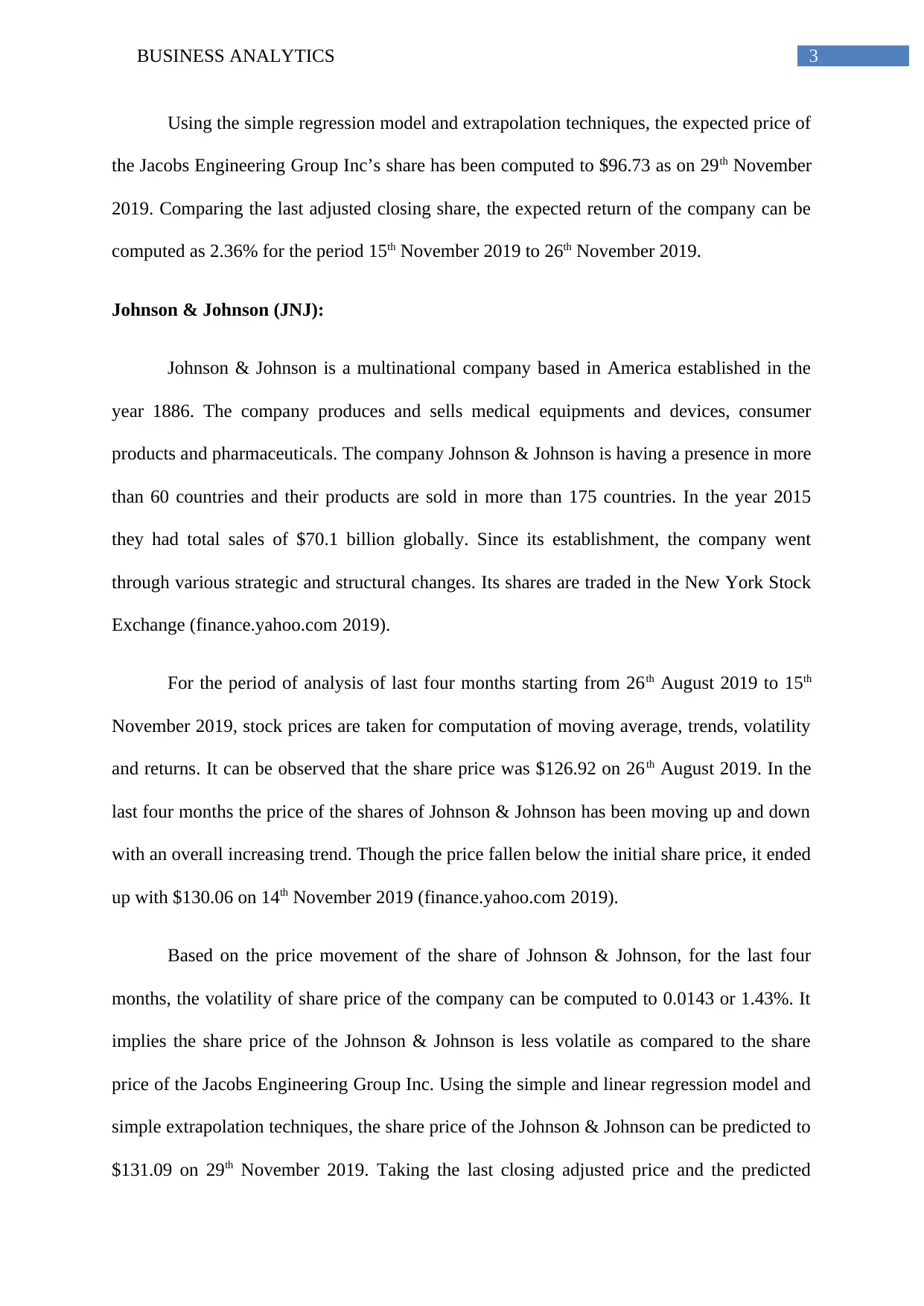
3BUSINESS ANALYTICS
Using the simple regression model and extrapolation techniques, the expected price of
the Jacobs Engineering Group Inc’s share has been computed to $96.73 as on 29th November
2019. Comparing the last adjusted closing share, the expected return of the company can be
computed as 2.36% for the period 15th November 2019 to 26th November 2019.
Johnson & Johnson (JNJ):
Johnson & Johnson is a multinational company based in America established in the
year 1886. The company produces and sells medical equipments and devices, consumer
products and pharmaceuticals. The company Johnson & Johnson is having a presence in more
than 60 countries and their products are sold in more than 175 countries. In the year 2015
they had total sales of $70.1 billion globally. Since its establishment, the company went
through various strategic and structural changes. Its shares are traded in the New York Stock
Exchange (finance.yahoo.com 2019).
For the period of analysis of last four months starting from 26th August 2019 to 15th
November 2019, stock prices are taken for computation of moving average, trends, volatility
and returns. It can be observed that the share price was $126.92 on 26th August 2019. In the
last four months the price of the shares of Johnson & Johnson has been moving up and down
with an overall increasing trend. Though the price fallen below the initial share price, it ended
up with $130.06 on 14th November 2019 (finance.yahoo.com 2019).
Based on the price movement of the share of Johnson & Johnson, for the last four
months, the volatility of share price of the company can be computed to 0.0143 or 1.43%. It
implies the share price of the Johnson & Johnson is less volatile as compared to the share
price of the Jacobs Engineering Group Inc. Using the simple and linear regression model and
simple extrapolation techniques, the share price of the Johnson & Johnson can be predicted to
$131.09 on 29th November 2019. Taking the last closing adjusted price and the predicted
Using the simple regression model and extrapolation techniques, the expected price of
the Jacobs Engineering Group Inc’s share has been computed to $96.73 as on 29th November
2019. Comparing the last adjusted closing share, the expected return of the company can be
computed as 2.36% for the period 15th November 2019 to 26th November 2019.
Johnson & Johnson (JNJ):
Johnson & Johnson is a multinational company based in America established in the
year 1886. The company produces and sells medical equipments and devices, consumer
products and pharmaceuticals. The company Johnson & Johnson is having a presence in more
than 60 countries and their products are sold in more than 175 countries. In the year 2015
they had total sales of $70.1 billion globally. Since its establishment, the company went
through various strategic and structural changes. Its shares are traded in the New York Stock
Exchange (finance.yahoo.com 2019).
For the period of analysis of last four months starting from 26th August 2019 to 15th
November 2019, stock prices are taken for computation of moving average, trends, volatility
and returns. It can be observed that the share price was $126.92 on 26th August 2019. In the
last four months the price of the shares of Johnson & Johnson has been moving up and down
with an overall increasing trend. Though the price fallen below the initial share price, it ended
up with $130.06 on 14th November 2019 (finance.yahoo.com 2019).
Based on the price movement of the share of Johnson & Johnson, for the last four
months, the volatility of share price of the company can be computed to 0.0143 or 1.43%. It
implies the share price of the Johnson & Johnson is less volatile as compared to the share
price of the Jacobs Engineering Group Inc. Using the simple and linear regression model and
simple extrapolation techniques, the share price of the Johnson & Johnson can be predicted to
$131.09 on 29th November 2019. Taking the last closing adjusted price and the predicted
Paraphrase This Document
Need a fresh take? Get an instant paraphrase of this document with our AI Paraphraser
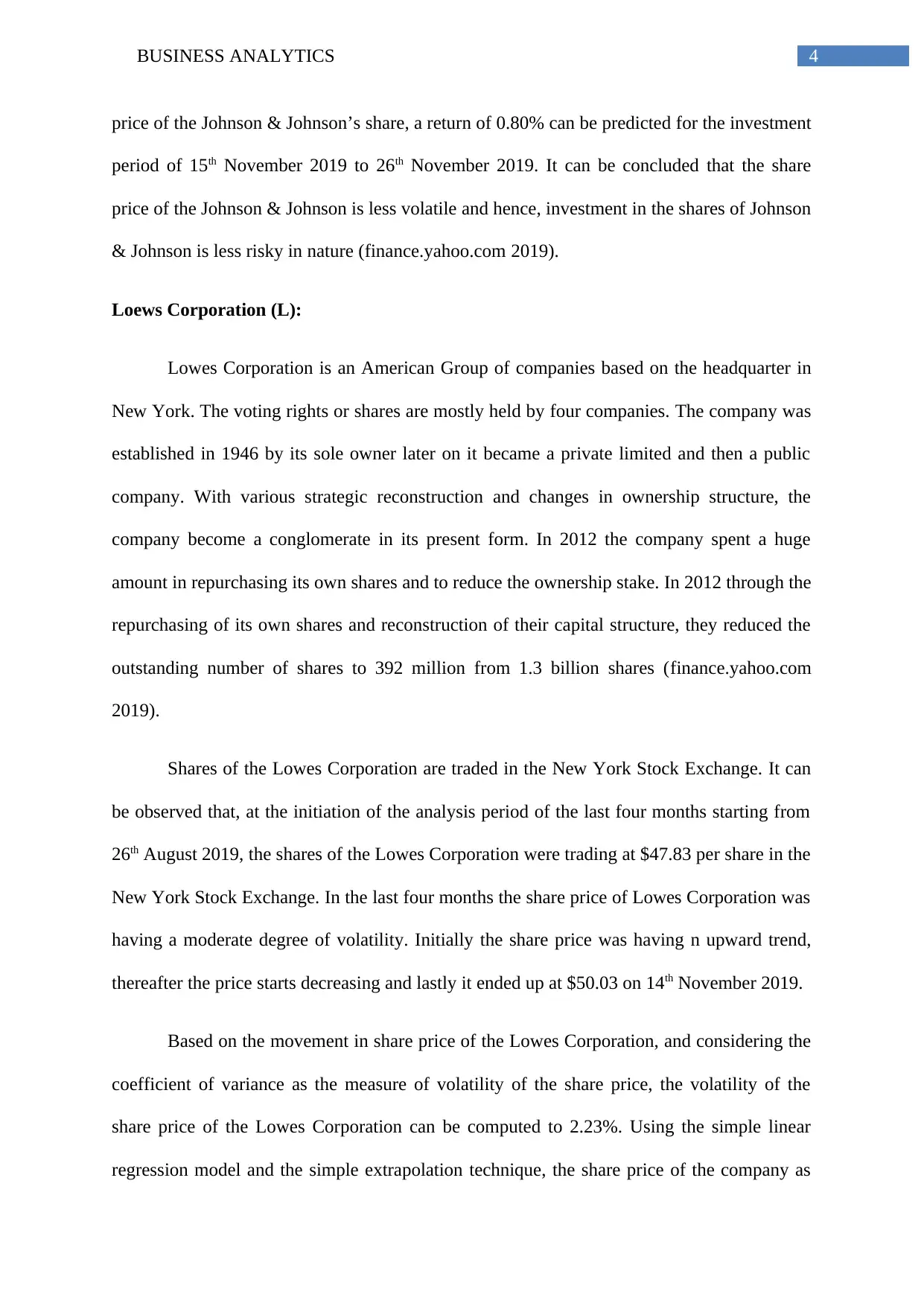
4BUSINESS ANALYTICS
price of the Johnson & Johnson’s share, a return of 0.80% can be predicted for the investment
period of 15th November 2019 to 26th November 2019. It can be concluded that the share
price of the Johnson & Johnson is less volatile and hence, investment in the shares of Johnson
& Johnson is less risky in nature (finance.yahoo.com 2019).
Loews Corporation (L):
Lowes Corporation is an American Group of companies based on the headquarter in
New York. The voting rights or shares are mostly held by four companies. The company was
established in 1946 by its sole owner later on it became a private limited and then a public
company. With various strategic reconstruction and changes in ownership structure, the
company become a conglomerate in its present form. In 2012 the company spent a huge
amount in repurchasing its own shares and to reduce the ownership stake. In 2012 through the
repurchasing of its own shares and reconstruction of their capital structure, they reduced the
outstanding number of shares to 392 million from 1.3 billion shares (finance.yahoo.com
2019).
Shares of the Lowes Corporation are traded in the New York Stock Exchange. It can
be observed that, at the initiation of the analysis period of the last four months starting from
26th August 2019, the shares of the Lowes Corporation were trading at $47.83 per share in the
New York Stock Exchange. In the last four months the share price of Lowes Corporation was
having a moderate degree of volatility. Initially the share price was having n upward trend,
thereafter the price starts decreasing and lastly it ended up at $50.03 on 14th November 2019.
Based on the movement in share price of the Lowes Corporation, and considering the
coefficient of variance as the measure of volatility of the share price, the volatility of the
share price of the Lowes Corporation can be computed to 2.23%. Using the simple linear
regression model and the simple extrapolation technique, the share price of the company as
price of the Johnson & Johnson’s share, a return of 0.80% can be predicted for the investment
period of 15th November 2019 to 26th November 2019. It can be concluded that the share
price of the Johnson & Johnson is less volatile and hence, investment in the shares of Johnson
& Johnson is less risky in nature (finance.yahoo.com 2019).
Loews Corporation (L):
Lowes Corporation is an American Group of companies based on the headquarter in
New York. The voting rights or shares are mostly held by four companies. The company was
established in 1946 by its sole owner later on it became a private limited and then a public
company. With various strategic reconstruction and changes in ownership structure, the
company become a conglomerate in its present form. In 2012 the company spent a huge
amount in repurchasing its own shares and to reduce the ownership stake. In 2012 through the
repurchasing of its own shares and reconstruction of their capital structure, they reduced the
outstanding number of shares to 392 million from 1.3 billion shares (finance.yahoo.com
2019).
Shares of the Lowes Corporation are traded in the New York Stock Exchange. It can
be observed that, at the initiation of the analysis period of the last four months starting from
26th August 2019, the shares of the Lowes Corporation were trading at $47.83 per share in the
New York Stock Exchange. In the last four months the share price of Lowes Corporation was
having a moderate degree of volatility. Initially the share price was having n upward trend,
thereafter the price starts decreasing and lastly it ended up at $50.03 on 14th November 2019.
Based on the movement in share price of the Lowes Corporation, and considering the
coefficient of variance as the measure of volatility of the share price, the volatility of the
share price of the Lowes Corporation can be computed to 2.23%. Using the simple linear
regression model and the simple extrapolation technique, the share price of the company as
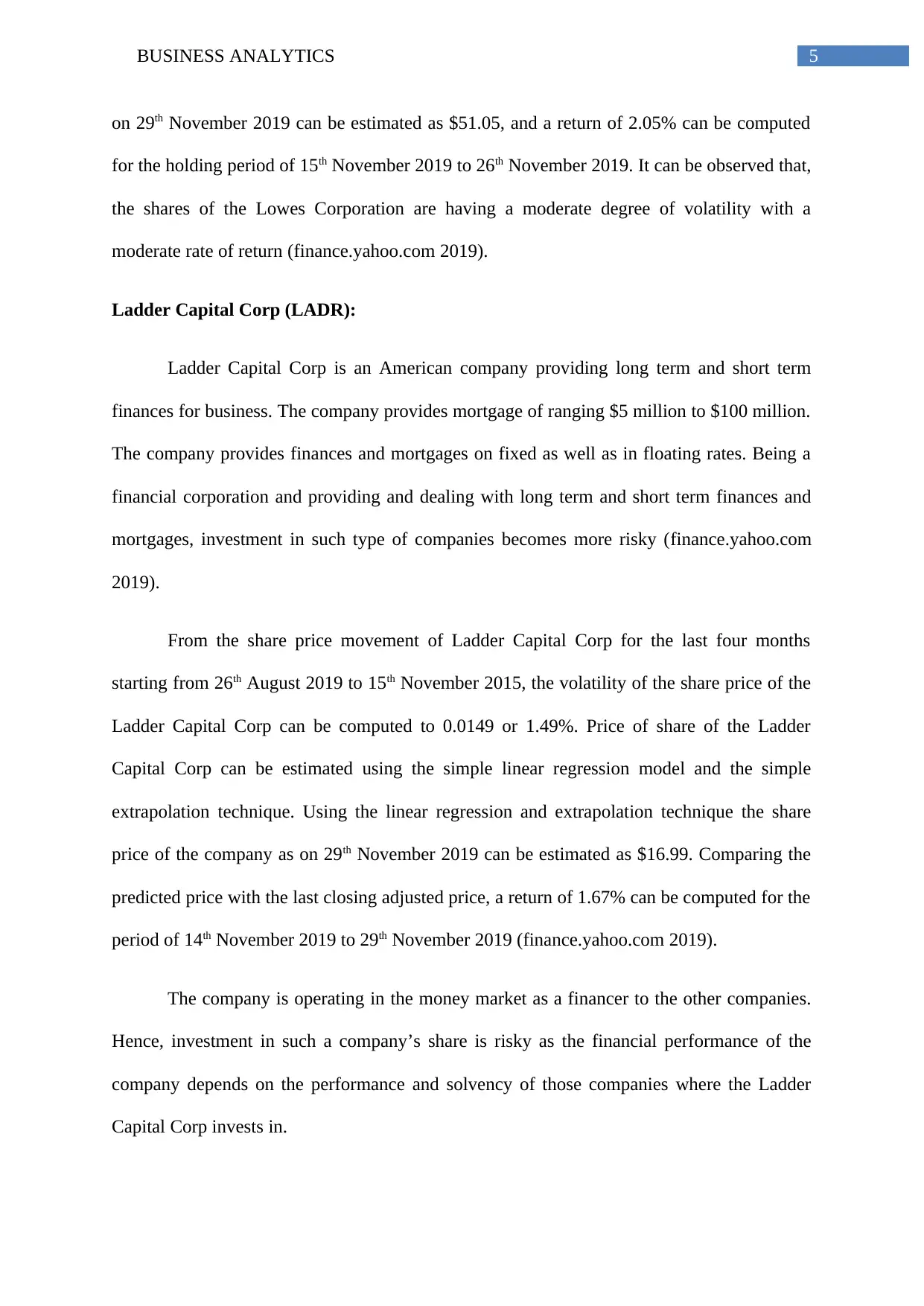
5BUSINESS ANALYTICS
on 29th November 2019 can be estimated as $51.05, and a return of 2.05% can be computed
for the holding period of 15th November 2019 to 26th November 2019. It can be observed that,
the shares of the Lowes Corporation are having a moderate degree of volatility with a
moderate rate of return (finance.yahoo.com 2019).
Ladder Capital Corp (LADR):
Ladder Capital Corp is an American company providing long term and short term
finances for business. The company provides mortgage of ranging $5 million to $100 million.
The company provides finances and mortgages on fixed as well as in floating rates. Being a
financial corporation and providing and dealing with long term and short term finances and
mortgages, investment in such type of companies becomes more risky (finance.yahoo.com
2019).
From the share price movement of Ladder Capital Corp for the last four months
starting from 26th August 2019 to 15th November 2015, the volatility of the share price of the
Ladder Capital Corp can be computed to 0.0149 or 1.49%. Price of share of the Ladder
Capital Corp can be estimated using the simple linear regression model and the simple
extrapolation technique. Using the linear regression and extrapolation technique the share
price of the company as on 29th November 2019 can be estimated as $16.99. Comparing the
predicted price with the last closing adjusted price, a return of 1.67% can be computed for the
period of 14th November 2019 to 29th November 2019 (finance.yahoo.com 2019).
The company is operating in the money market as a financer to the other companies.
Hence, investment in such a company’s share is risky as the financial performance of the
company depends on the performance and solvency of those companies where the Ladder
Capital Corp invests in.
on 29th November 2019 can be estimated as $51.05, and a return of 2.05% can be computed
for the holding period of 15th November 2019 to 26th November 2019. It can be observed that,
the shares of the Lowes Corporation are having a moderate degree of volatility with a
moderate rate of return (finance.yahoo.com 2019).
Ladder Capital Corp (LADR):
Ladder Capital Corp is an American company providing long term and short term
finances for business. The company provides mortgage of ranging $5 million to $100 million.
The company provides finances and mortgages on fixed as well as in floating rates. Being a
financial corporation and providing and dealing with long term and short term finances and
mortgages, investment in such type of companies becomes more risky (finance.yahoo.com
2019).
From the share price movement of Ladder Capital Corp for the last four months
starting from 26th August 2019 to 15th November 2015, the volatility of the share price of the
Ladder Capital Corp can be computed to 0.0149 or 1.49%. Price of share of the Ladder
Capital Corp can be estimated using the simple linear regression model and the simple
extrapolation technique. Using the linear regression and extrapolation technique the share
price of the company as on 29th November 2019 can be estimated as $16.99. Comparing the
predicted price with the last closing adjusted price, a return of 1.67% can be computed for the
period of 14th November 2019 to 29th November 2019 (finance.yahoo.com 2019).
The company is operating in the money market as a financer to the other companies.
Hence, investment in such a company’s share is risky as the financial performance of the
company depends on the performance and solvency of those companies where the Ladder
Capital Corp invests in.
⊘ This is a preview!⊘
Do you want full access?
Subscribe today to unlock all pages.

Trusted by 1+ million students worldwide
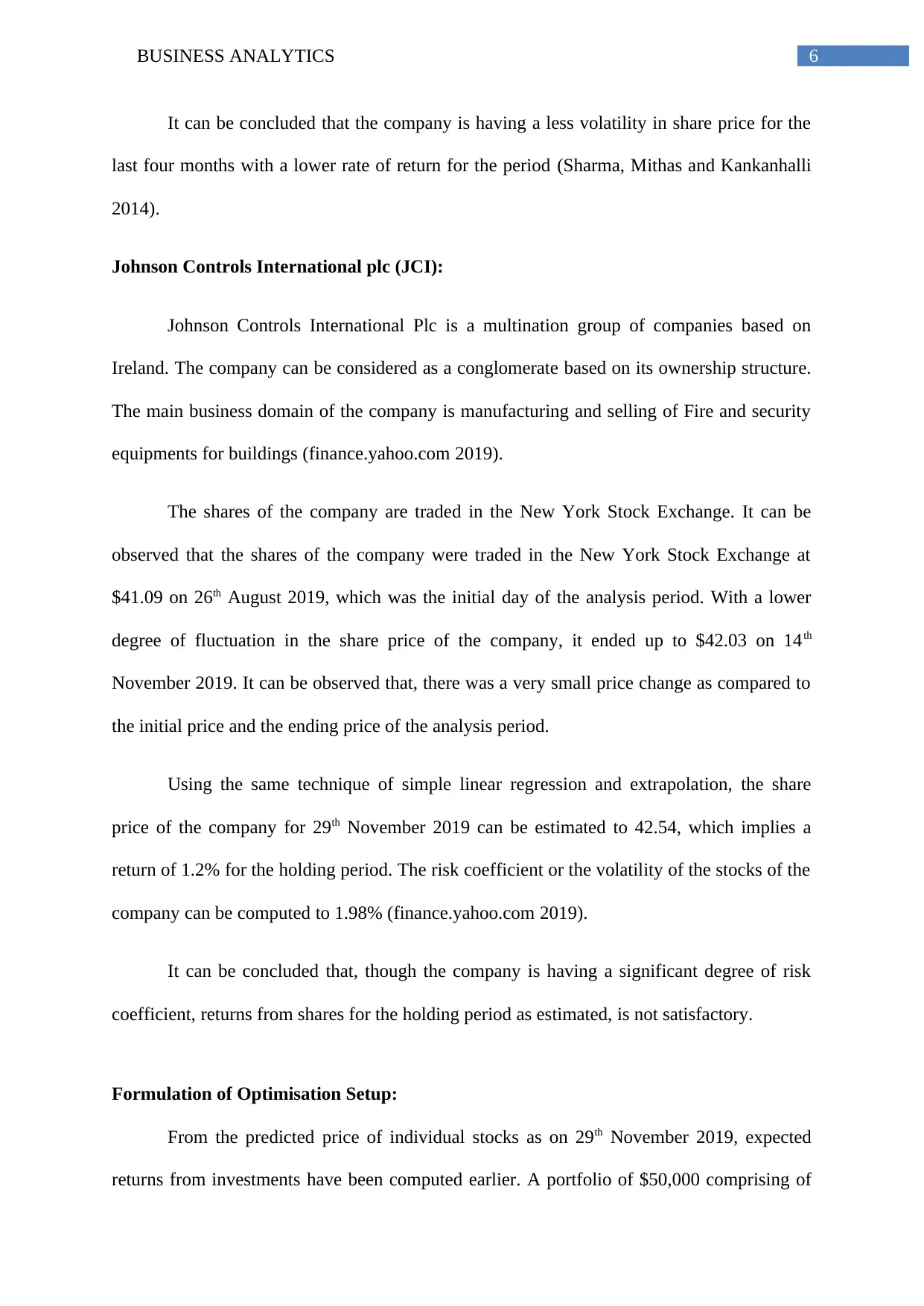
6BUSINESS ANALYTICS
It can be concluded that the company is having a less volatility in share price for the
last four months with a lower rate of return for the period (Sharma, Mithas and Kankanhalli
2014).
Johnson Controls International plc (JCI):
Johnson Controls International Plc is a multination group of companies based on
Ireland. The company can be considered as a conglomerate based on its ownership structure.
The main business domain of the company is manufacturing and selling of Fire and security
equipments for buildings (finance.yahoo.com 2019).
The shares of the company are traded in the New York Stock Exchange. It can be
observed that the shares of the company were traded in the New York Stock Exchange at
$41.09 on 26th August 2019, which was the initial day of the analysis period. With a lower
degree of fluctuation in the share price of the company, it ended up to $42.03 on 14th
November 2019. It can be observed that, there was a very small price change as compared to
the initial price and the ending price of the analysis period.
Using the same technique of simple linear regression and extrapolation, the share
price of the company for 29th November 2019 can be estimated to 42.54, which implies a
return of 1.2% for the holding period. The risk coefficient or the volatility of the stocks of the
company can be computed to 1.98% (finance.yahoo.com 2019).
It can be concluded that, though the company is having a significant degree of risk
coefficient, returns from shares for the holding period as estimated, is not satisfactory.
Formulation of Optimisation Setup:
From the predicted price of individual stocks as on 29th November 2019, expected
returns from investments have been computed earlier. A portfolio of $50,000 comprising of
It can be concluded that the company is having a less volatility in share price for the
last four months with a lower rate of return for the period (Sharma, Mithas and Kankanhalli
2014).
Johnson Controls International plc (JCI):
Johnson Controls International Plc is a multination group of companies based on
Ireland. The company can be considered as a conglomerate based on its ownership structure.
The main business domain of the company is manufacturing and selling of Fire and security
equipments for buildings (finance.yahoo.com 2019).
The shares of the company are traded in the New York Stock Exchange. It can be
observed that the shares of the company were traded in the New York Stock Exchange at
$41.09 on 26th August 2019, which was the initial day of the analysis period. With a lower
degree of fluctuation in the share price of the company, it ended up to $42.03 on 14th
November 2019. It can be observed that, there was a very small price change as compared to
the initial price and the ending price of the analysis period.
Using the same technique of simple linear regression and extrapolation, the share
price of the company for 29th November 2019 can be estimated to 42.54, which implies a
return of 1.2% for the holding period. The risk coefficient or the volatility of the stocks of the
company can be computed to 1.98% (finance.yahoo.com 2019).
It can be concluded that, though the company is having a significant degree of risk
coefficient, returns from shares for the holding period as estimated, is not satisfactory.
Formulation of Optimisation Setup:
From the predicted price of individual stocks as on 29th November 2019, expected
returns from investments have been computed earlier. A portfolio of $50,000 comprising of
Paraphrase This Document
Need a fresh take? Get an instant paraphrase of this document with our AI Paraphraser
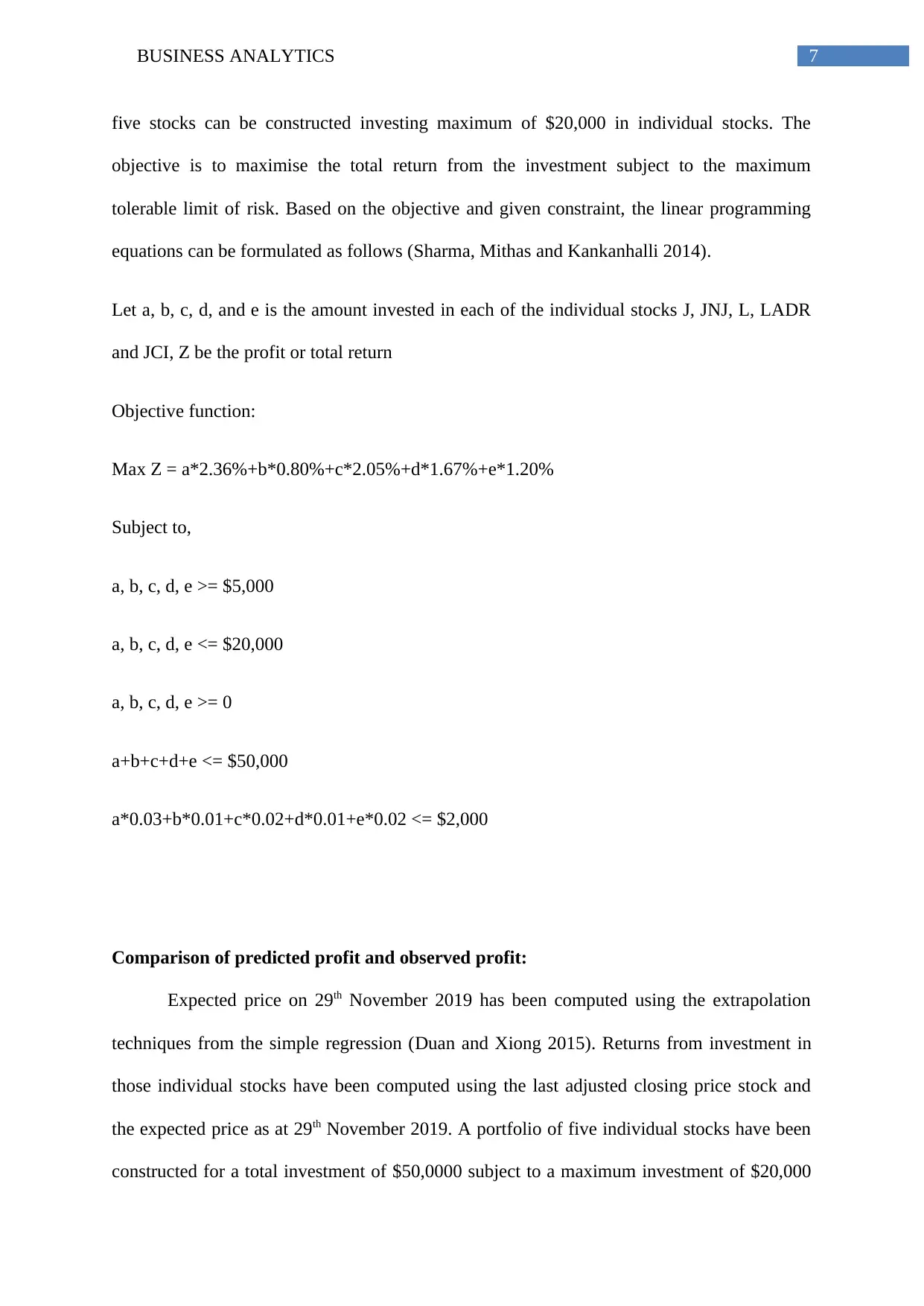
7BUSINESS ANALYTICS
five stocks can be constructed investing maximum of $20,000 in individual stocks. The
objective is to maximise the total return from the investment subject to the maximum
tolerable limit of risk. Based on the objective and given constraint, the linear programming
equations can be formulated as follows (Sharma, Mithas and Kankanhalli 2014).
Let a, b, c, d, and e is the amount invested in each of the individual stocks J, JNJ, L, LADR
and JCI, Z be the profit or total return
Objective function:
Max Z = a*2.36%+b*0.80%+c*2.05%+d*1.67%+e*1.20%
Subject to,
a, b, c, d, e >= $5,000
a, b, c, d, e <= $20,000
a, b, c, d, e >= 0
a+b+c+d+e <= $50,000
a*0.03+b*0.01+c*0.02+d*0.01+e*0.02 <= $2,000
Comparison of predicted profit and observed profit:
Expected price on 29th November 2019 has been computed using the extrapolation
techniques from the simple regression (Duan and Xiong 2015). Returns from investment in
those individual stocks have been computed using the last adjusted closing price stock and
the expected price as at 29th November 2019. A portfolio of five individual stocks have been
constructed for a total investment of $50,0000 subject to a maximum investment of $20,000
five stocks can be constructed investing maximum of $20,000 in individual stocks. The
objective is to maximise the total return from the investment subject to the maximum
tolerable limit of risk. Based on the objective and given constraint, the linear programming
equations can be formulated as follows (Sharma, Mithas and Kankanhalli 2014).
Let a, b, c, d, and e is the amount invested in each of the individual stocks J, JNJ, L, LADR
and JCI, Z be the profit or total return
Objective function:
Max Z = a*2.36%+b*0.80%+c*2.05%+d*1.67%+e*1.20%
Subject to,
a, b, c, d, e >= $5,000
a, b, c, d, e <= $20,000
a, b, c, d, e >= 0
a+b+c+d+e <= $50,000
a*0.03+b*0.01+c*0.02+d*0.01+e*0.02 <= $2,000
Comparison of predicted profit and observed profit:
Expected price on 29th November 2019 has been computed using the extrapolation
techniques from the simple regression (Duan and Xiong 2015). Returns from investment in
those individual stocks have been computed using the last adjusted closing price stock and
the expected price as at 29th November 2019. A portfolio of five individual stocks have been
constructed for a total investment of $50,0000 subject to a maximum investment of $20,000
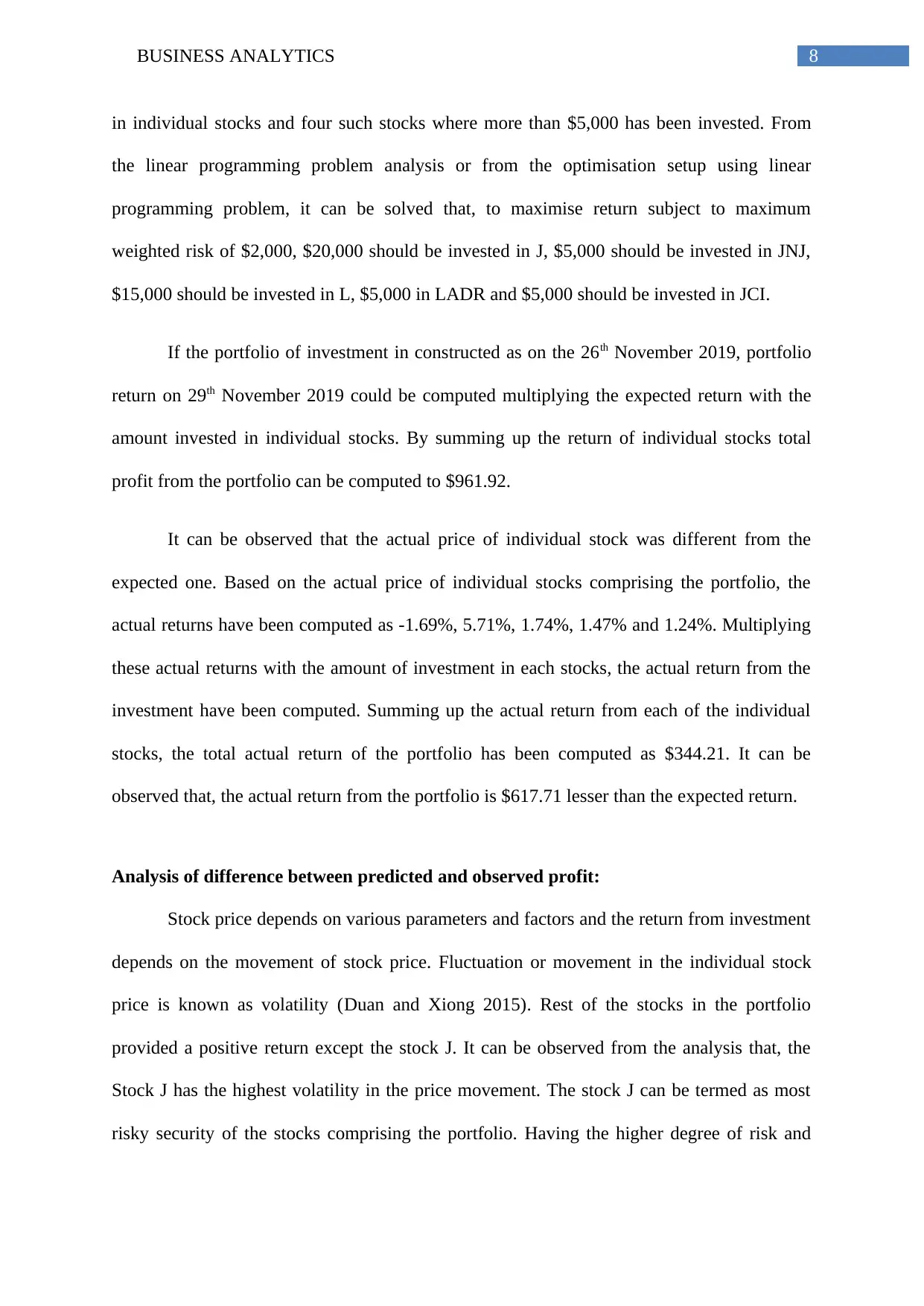
8BUSINESS ANALYTICS
in individual stocks and four such stocks where more than $5,000 has been invested. From
the linear programming problem analysis or from the optimisation setup using linear
programming problem, it can be solved that, to maximise return subject to maximum
weighted risk of $2,000, $20,000 should be invested in J, $5,000 should be invested in JNJ,
$15,000 should be invested in L, $5,000 in LADR and $5,000 should be invested in JCI.
If the portfolio of investment in constructed as on the 26th November 2019, portfolio
return on 29th November 2019 could be computed multiplying the expected return with the
amount invested in individual stocks. By summing up the return of individual stocks total
profit from the portfolio can be computed to $961.92.
It can be observed that the actual price of individual stock was different from the
expected one. Based on the actual price of individual stocks comprising the portfolio, the
actual returns have been computed as -1.69%, 5.71%, 1.74%, 1.47% and 1.24%. Multiplying
these actual returns with the amount of investment in each stocks, the actual return from the
investment have been computed. Summing up the actual return from each of the individual
stocks, the total actual return of the portfolio has been computed as $344.21. It can be
observed that, the actual return from the portfolio is $617.71 lesser than the expected return.
Analysis of difference between predicted and observed profit:
Stock price depends on various parameters and factors and the return from investment
depends on the movement of stock price. Fluctuation or movement in the individual stock
price is known as volatility (Duan and Xiong 2015). Rest of the stocks in the portfolio
provided a positive return except the stock J. It can be observed from the analysis that, the
Stock J has the highest volatility in the price movement. The stock J can be termed as most
risky security of the stocks comprising the portfolio. Having the higher degree of risk and
in individual stocks and four such stocks where more than $5,000 has been invested. From
the linear programming problem analysis or from the optimisation setup using linear
programming problem, it can be solved that, to maximise return subject to maximum
weighted risk of $2,000, $20,000 should be invested in J, $5,000 should be invested in JNJ,
$15,000 should be invested in L, $5,000 in LADR and $5,000 should be invested in JCI.
If the portfolio of investment in constructed as on the 26th November 2019, portfolio
return on 29th November 2019 could be computed multiplying the expected return with the
amount invested in individual stocks. By summing up the return of individual stocks total
profit from the portfolio can be computed to $961.92.
It can be observed that the actual price of individual stock was different from the
expected one. Based on the actual price of individual stocks comprising the portfolio, the
actual returns have been computed as -1.69%, 5.71%, 1.74%, 1.47% and 1.24%. Multiplying
these actual returns with the amount of investment in each stocks, the actual return from the
investment have been computed. Summing up the actual return from each of the individual
stocks, the total actual return of the portfolio has been computed as $344.21. It can be
observed that, the actual return from the portfolio is $617.71 lesser than the expected return.
Analysis of difference between predicted and observed profit:
Stock price depends on various parameters and factors and the return from investment
depends on the movement of stock price. Fluctuation or movement in the individual stock
price is known as volatility (Duan and Xiong 2015). Rest of the stocks in the portfolio
provided a positive return except the stock J. It can be observed from the analysis that, the
Stock J has the highest volatility in the price movement. The stock J can be termed as most
risky security of the stocks comprising the portfolio. Having the higher degree of risk and
⊘ This is a preview!⊘
Do you want full access?
Subscribe today to unlock all pages.

Trusted by 1+ million students worldwide
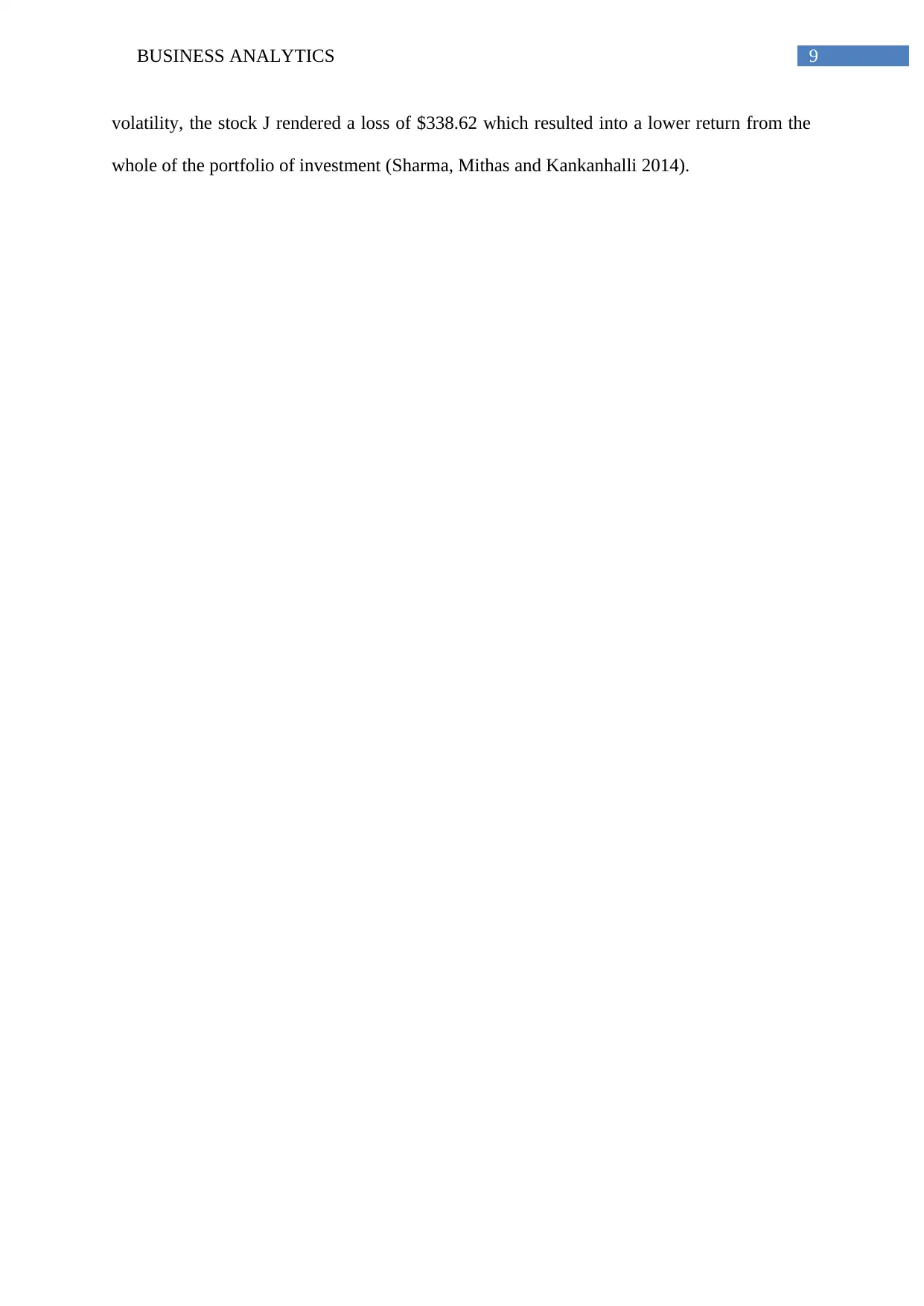
9BUSINESS ANALYTICS
volatility, the stock J rendered a loss of $338.62 which resulted into a lower return from the
whole of the portfolio of investment (Sharma, Mithas and Kankanhalli 2014).
volatility, the stock J rendered a loss of $338.62 which resulted into a lower return from the
whole of the portfolio of investment (Sharma, Mithas and Kankanhalli 2014).
Paraphrase This Document
Need a fresh take? Get an instant paraphrase of this document with our AI Paraphraser
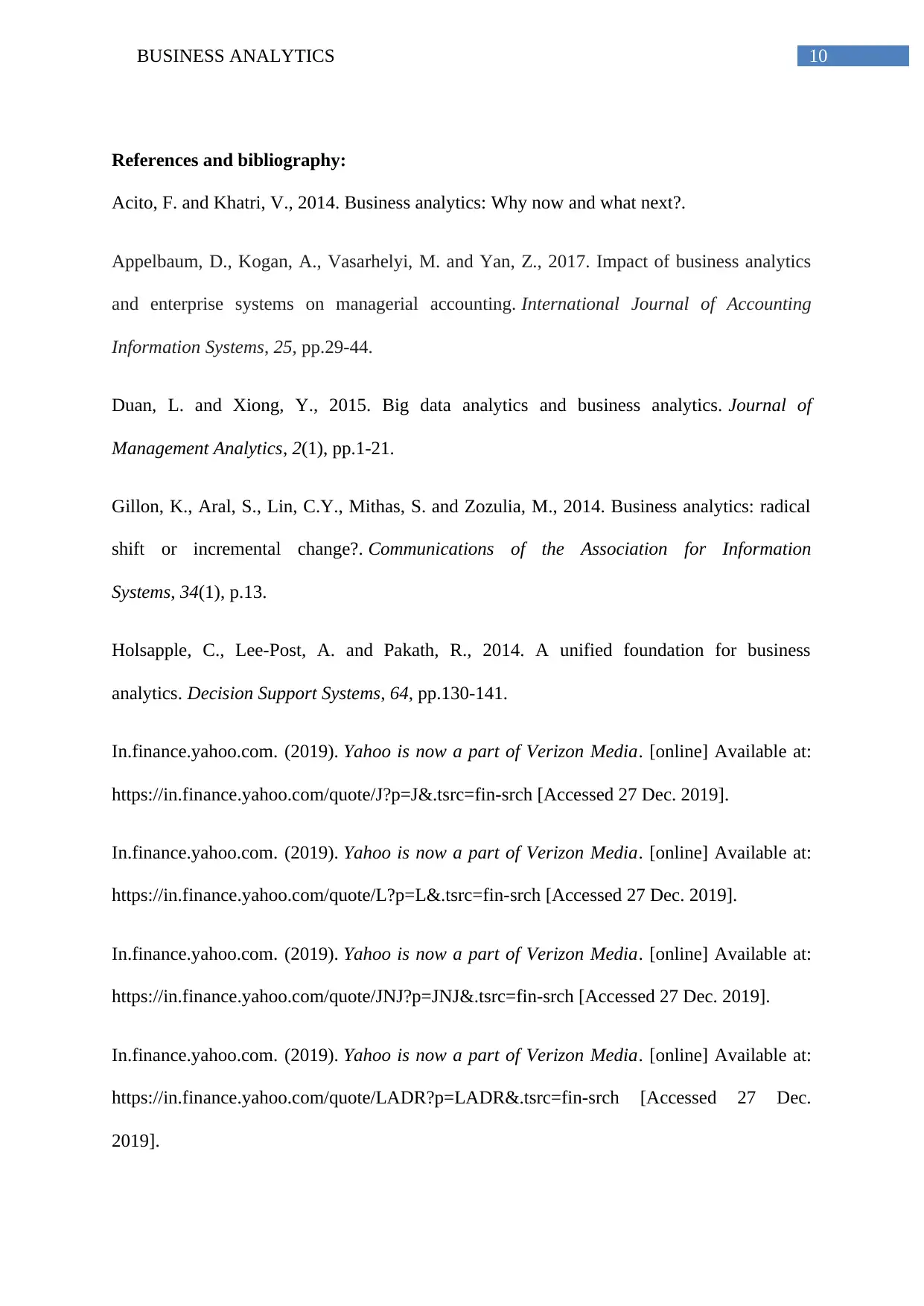
10BUSINESS ANALYTICS
References and bibliography:
Acito, F. and Khatri, V., 2014. Business analytics: Why now and what next?.
Appelbaum, D., Kogan, A., Vasarhelyi, M. and Yan, Z., 2017. Impact of business analytics
and enterprise systems on managerial accounting. International Journal of Accounting
Information Systems, 25, pp.29-44.
Duan, L. and Xiong, Y., 2015. Big data analytics and business analytics. Journal of
Management Analytics, 2(1), pp.1-21.
Gillon, K., Aral, S., Lin, C.Y., Mithas, S. and Zozulia, M., 2014. Business analytics: radical
shift or incremental change?. Communications of the Association for Information
Systems, 34(1), p.13.
Holsapple, C., Lee-Post, A. and Pakath, R., 2014. A unified foundation for business
analytics. Decision Support Systems, 64, pp.130-141.
In.finance.yahoo.com. (2019). Yahoo is now a part of Verizon Media. [online] Available at:
https://in.finance.yahoo.com/quote/J?p=J&.tsrc=fin-srch [Accessed 27 Dec. 2019].
In.finance.yahoo.com. (2019). Yahoo is now a part of Verizon Media. [online] Available at:
https://in.finance.yahoo.com/quote/L?p=L&.tsrc=fin-srch [Accessed 27 Dec. 2019].
In.finance.yahoo.com. (2019). Yahoo is now a part of Verizon Media. [online] Available at:
https://in.finance.yahoo.com/quote/JNJ?p=JNJ&.tsrc=fin-srch [Accessed 27 Dec. 2019].
In.finance.yahoo.com. (2019). Yahoo is now a part of Verizon Media. [online] Available at:
https://in.finance.yahoo.com/quote/LADR?p=LADR&.tsrc=fin-srch [Accessed 27 Dec.
2019].
References and bibliography:
Acito, F. and Khatri, V., 2014. Business analytics: Why now and what next?.
Appelbaum, D., Kogan, A., Vasarhelyi, M. and Yan, Z., 2017. Impact of business analytics
and enterprise systems on managerial accounting. International Journal of Accounting
Information Systems, 25, pp.29-44.
Duan, L. and Xiong, Y., 2015. Big data analytics and business analytics. Journal of
Management Analytics, 2(1), pp.1-21.
Gillon, K., Aral, S., Lin, C.Y., Mithas, S. and Zozulia, M., 2014. Business analytics: radical
shift or incremental change?. Communications of the Association for Information
Systems, 34(1), p.13.
Holsapple, C., Lee-Post, A. and Pakath, R., 2014. A unified foundation for business
analytics. Decision Support Systems, 64, pp.130-141.
In.finance.yahoo.com. (2019). Yahoo is now a part of Verizon Media. [online] Available at:
https://in.finance.yahoo.com/quote/J?p=J&.tsrc=fin-srch [Accessed 27 Dec. 2019].
In.finance.yahoo.com. (2019). Yahoo is now a part of Verizon Media. [online] Available at:
https://in.finance.yahoo.com/quote/L?p=L&.tsrc=fin-srch [Accessed 27 Dec. 2019].
In.finance.yahoo.com. (2019). Yahoo is now a part of Verizon Media. [online] Available at:
https://in.finance.yahoo.com/quote/JNJ?p=JNJ&.tsrc=fin-srch [Accessed 27 Dec. 2019].
In.finance.yahoo.com. (2019). Yahoo is now a part of Verizon Media. [online] Available at:
https://in.finance.yahoo.com/quote/LADR?p=LADR&.tsrc=fin-srch [Accessed 27 Dec.
2019].
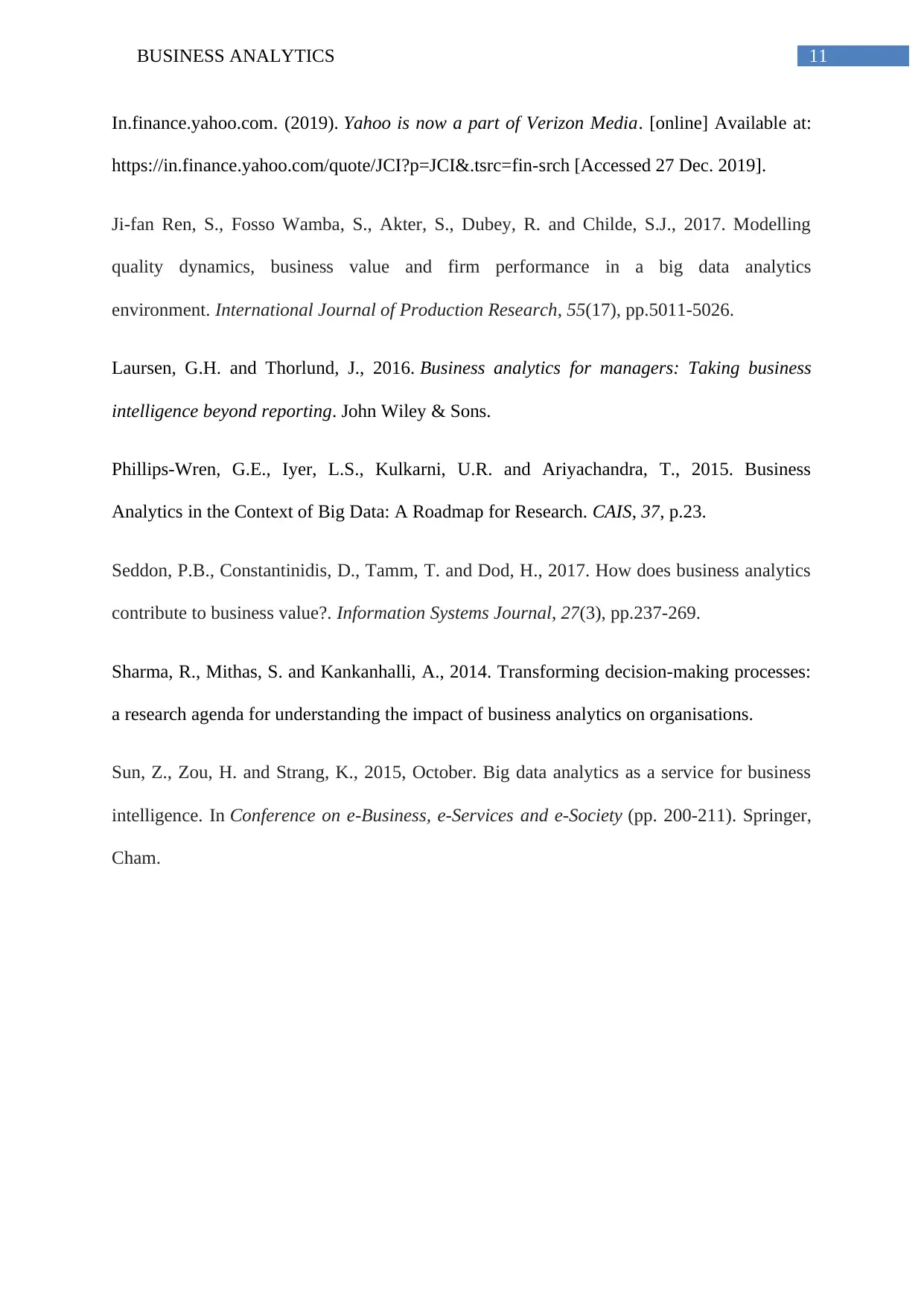
11BUSINESS ANALYTICS
In.finance.yahoo.com. (2019). Yahoo is now a part of Verizon Media. [online] Available at:
https://in.finance.yahoo.com/quote/JCI?p=JCI&.tsrc=fin-srch [Accessed 27 Dec. 2019].
Ji-fan Ren, S., Fosso Wamba, S., Akter, S., Dubey, R. and Childe, S.J., 2017. Modelling
quality dynamics, business value and firm performance in a big data analytics
environment. International Journal of Production Research, 55(17), pp.5011-5026.
Laursen, G.H. and Thorlund, J., 2016. Business analytics for managers: Taking business
intelligence beyond reporting. John Wiley & Sons.
Phillips-Wren, G.E., Iyer, L.S., Kulkarni, U.R. and Ariyachandra, T., 2015. Business
Analytics in the Context of Big Data: A Roadmap for Research. CAIS, 37, p.23.
Seddon, P.B., Constantinidis, D., Tamm, T. and Dod, H., 2017. How does business analytics
contribute to business value?. Information Systems Journal, 27(3), pp.237-269.
Sharma, R., Mithas, S. and Kankanhalli, A., 2014. Transforming decision-making processes:
a research agenda for understanding the impact of business analytics on organisations.
Sun, Z., Zou, H. and Strang, K., 2015, October. Big data analytics as a service for business
intelligence. In Conference on e-Business, e-Services and e-Society (pp. 200-211). Springer,
Cham.
In.finance.yahoo.com. (2019). Yahoo is now a part of Verizon Media. [online] Available at:
https://in.finance.yahoo.com/quote/JCI?p=JCI&.tsrc=fin-srch [Accessed 27 Dec. 2019].
Ji-fan Ren, S., Fosso Wamba, S., Akter, S., Dubey, R. and Childe, S.J., 2017. Modelling
quality dynamics, business value and firm performance in a big data analytics
environment. International Journal of Production Research, 55(17), pp.5011-5026.
Laursen, G.H. and Thorlund, J., 2016. Business analytics for managers: Taking business
intelligence beyond reporting. John Wiley & Sons.
Phillips-Wren, G.E., Iyer, L.S., Kulkarni, U.R. and Ariyachandra, T., 2015. Business
Analytics in the Context of Big Data: A Roadmap for Research. CAIS, 37, p.23.
Seddon, P.B., Constantinidis, D., Tamm, T. and Dod, H., 2017. How does business analytics
contribute to business value?. Information Systems Journal, 27(3), pp.237-269.
Sharma, R., Mithas, S. and Kankanhalli, A., 2014. Transforming decision-making processes:
a research agenda for understanding the impact of business analytics on organisations.
Sun, Z., Zou, H. and Strang, K., 2015, October. Big data analytics as a service for business
intelligence. In Conference on e-Business, e-Services and e-Society (pp. 200-211). Springer,
Cham.
⊘ This is a preview!⊘
Do you want full access?
Subscribe today to unlock all pages.

Trusted by 1+ million students worldwide
1 out of 12
Your All-in-One AI-Powered Toolkit for Academic Success.
+13062052269
info@desklib.com
Available 24*7 on WhatsApp / Email
![[object Object]](/_next/static/media/star-bottom.7253800d.svg)
Unlock your academic potential
Copyright © 2020–2025 A2Z Services. All Rights Reserved. Developed and managed by ZUCOL.